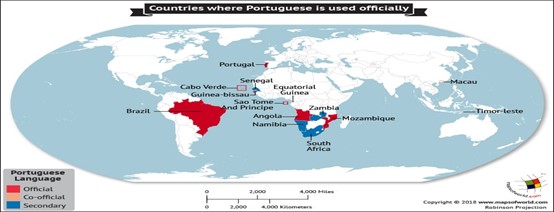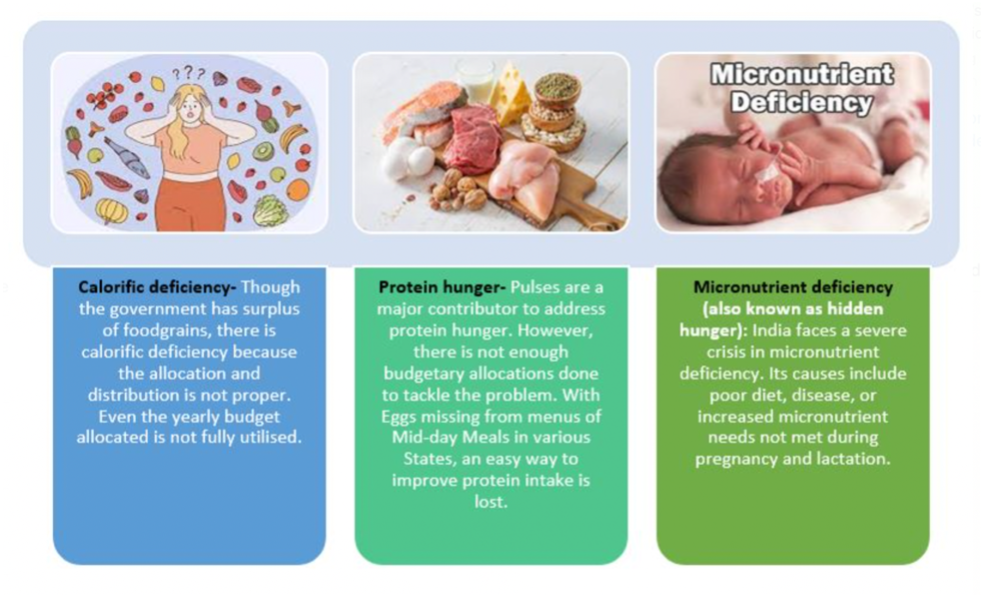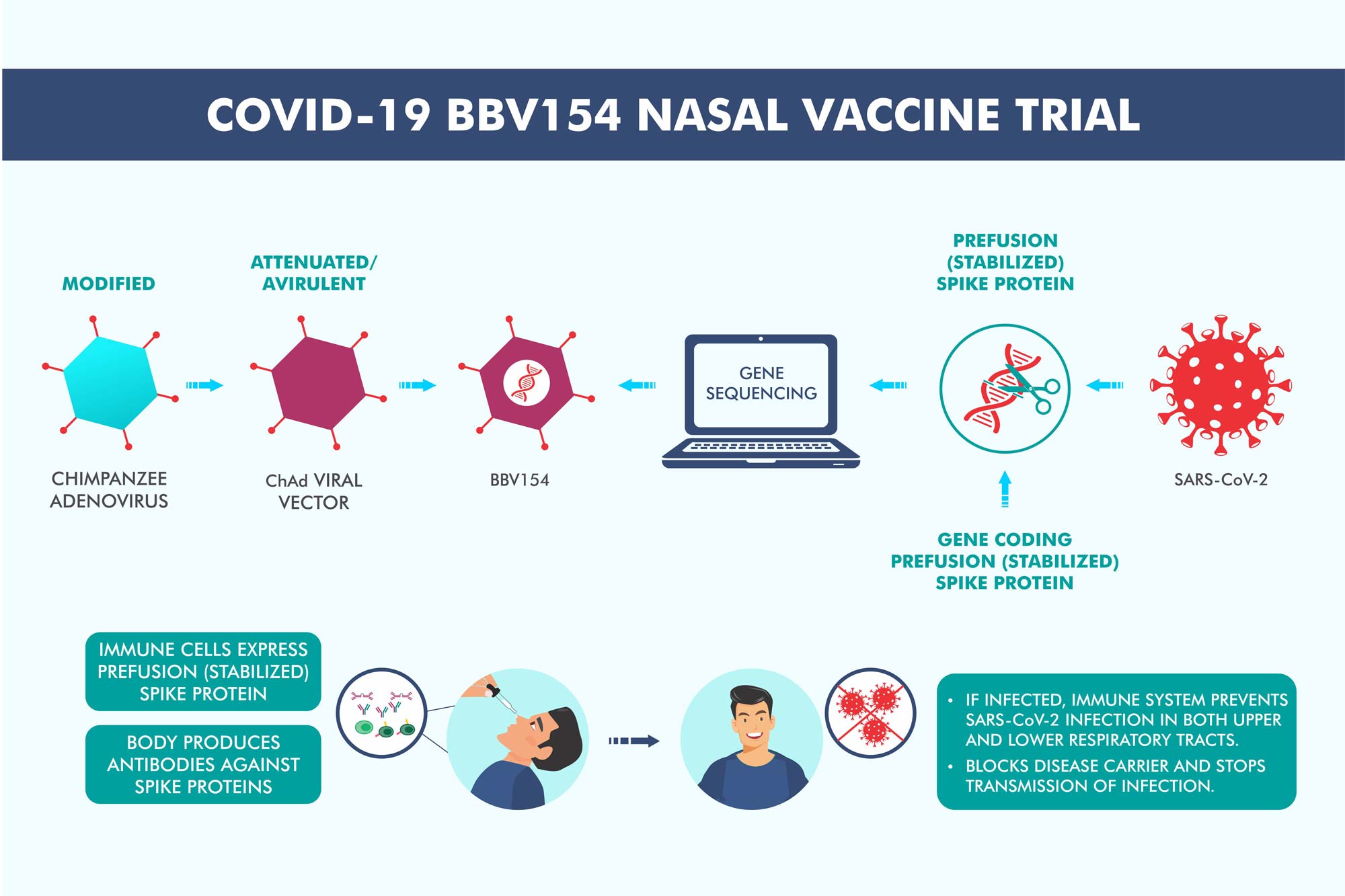Tuesday, 6th December 2022
Global report on health equity for PwD
In News:
- WHO releases report on persons with disabilities
About the News:
- World Health Organisation (WHO) has recently released a report titled 'Global report on health equity for persons with disabilities'.
- The report highlights the systemic and persistent health inequities faced by persons with disabilities which leads to much earlier deaths for them in comparison to normal persons.
- It also provides a comprehensive analysis of health sector challenges globally as well as the actions needed to ensure the highest attainable standard of health for persons with disabilities.
- The report calls on WHO Member States to take action to advance health equity for persons with disabilities to facilitate them to achieve the highest attainable standard of health.
- While substantial progress has been made in many countries in recent years, the world is still far from realizing the right to the highest attainable standard of health for PwDs.
Major findings of the report:
- Disadvantaged class: The number of people with significant disabilities has risen to 1.3 billion people globally.
- Earlier deaths: Persons with disabilities die earlier, many up to 20 years, and have higher rates of chronic health conditions.
- Discrimination: Many PwDs experience discrimination, including in the health sector and are often disadvantaged in healthcare access and face stigma, abuse and neglect.
- Human capital: For every 1 US Dollar spent on disability-inclusive prevention and care of noncommunicable diseases, governments could expect a return of 10 US Dollars.
Major recommendations of the report:
About: The report contains 40 disability-targeted actions that countries can take to strengthen their health systems and reduce health inequities for persons with disabilities.
- Facilitate inclusion: Persons with disabilities should be included in health equity at the centre of any health sector action.
- Empowerment: Ensure facilitation and meaningful participation of persons with disabilities and their representative organizations when implementing any health sector action
- Accountability: Countries should monitor and evaluate the extent to which health sector actions are leading to health equity for persons with disabilities
Source:
https://www.downtoearth.org.in/news/health/health-inequities-to-be-blamed-for-premature-deaths-among-people-with-disabilities-who-86332#:~:text=Published%3A%20Friday%2002%20December%202022&text=Many%20people%20with%20disabilities%20run,for%20persons%20with%20disabilities%20report
Original report:
https://www.who.int/publications/i/item/9789240063600
Click the link below to attempt the daily MCQs and the Mains based questions.
Internal displacement Report - Edukemy Current Affairs
In news
According to the report titled 'Turning the tide on internal displacement: A development approach to solutions' by United Nations Development Programme (UNDP), for the first time ever more than 100 million people were forcibly displaced in 2022, with most of them within their own countries.
About the report
Statistics
- At the end of 2021, there were over 59 million people forcibly displaced within their own countries due to conflict, violence, disasters and climate change.
- Further, by 2050, climate change could force more than an estimated 216 million people to move within their own countries.
- The analysis in the report showed that 48% of the internally displaced households surveyed earned less money than before displacement, with the most impacted being the Female and youth-headed
- Around 31% of the respondents said their health worsened following displacement.
Impact
- These internally displaced persons (IDP) struggle to cover their basic needs, find decent work or have a stable source of income, among other challenges, the global body highlighted, describing their plight as an ‘invisible crisis’ due to gaps.
- For years, sub-Saharan Africa, the Middle East and North Africa and parts of the Americas have been the regions most affected by internal displacement linked with conflicts and violence.
- With displacement, many affected countries will not be able to reach their United Nations-mandated Sustainable Development Goals including the critical ones on poverty, education, peaceful societies and gender equality, flagged UNDP.
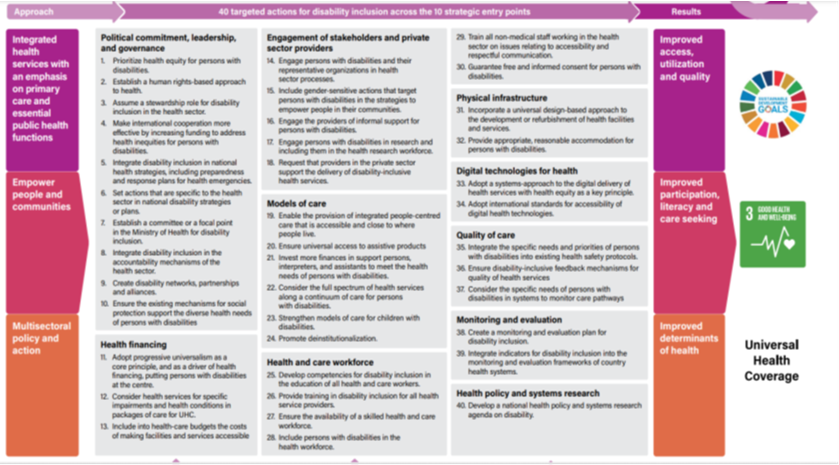

Solutions
- The pathways suggested to development solutions include:
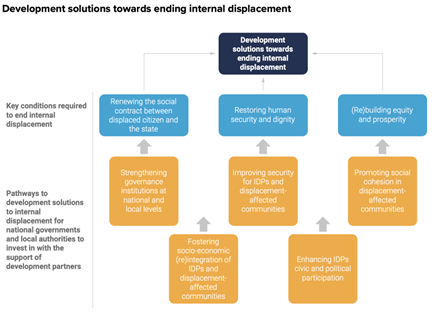
-
- Strengthening governance institutions
- Boosting socioeconomic integration through access to jobs and services
- Restoring security
- Enhancing participation
- Building social cohesion
- Also, UNDP called for countries to take political, social and economic measures to ensure that IDPs can exercise their full rights as citizens, including in political processes.
IDP in India
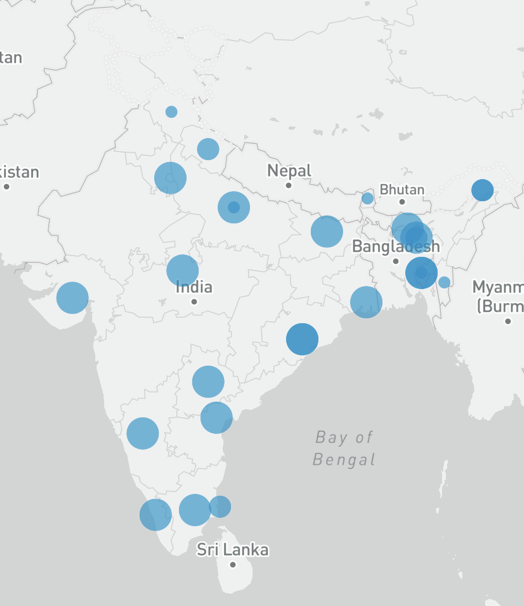
- Nearly five million people in India were internally displaced due to climate change and disasters in 2021, the United Nations has said in a report.
- The scale of displacement is a result of the country’s exposure to intense and frequent hazards, its large population and socio-economic vulnerability.
- Floods and cyclones, which are influenced by the southwest and north-east monsoon seasons, are the main trigger of disaster displacement.
Source:
Turning the Tide on Internal Displacement
Number of people forcibly displaced crossed 100 million in 2022: UNDP
Image source:
https://www.undp.org/publications/turning-tide-internal-displacement-development-approach-solutions
https://www.internal-displacement.org/countries/india
Click the link below to attempt the daily MCQs and the Mains based questions.
India-Lusophone Relations - Edukemy Current Affairs
Why in news?
- In a novel diplomatic step, India is moving in to strategically engage with a new geopolitical grouping: the Lusophone (Portuguese-speaking countries) in order to leverage the untapped potential and the historical connect.
- In order to boost its ties with the Lusophone World, India is hosting a four-day cultural extravaganza in Goa.
- The International Lusophone Festival kicked off at Raj Bhawan in Goa on 3rd
|
About Lusophone Countries
|
About CPLP
- The Lusophone Commonwealth (Comunidade Lusofona), commonly known as the Community of Portuguese Language Countries (Comunidade dos Pases de Lngua Portuguesa), is a multilateral organisation that was established on July 17, 1996, at the first CPLP Heads of State & Government Summit in Lisbon.
- Along with Portugal, the founding members included Angola, Brazil, Cabo Verde, Guinea Bissau, Mozambique, Sao Tome and Principe, Timor Leste, and Equatorial Guinea. Timor Leste and Equatorial Guinea joined later.
- These countries comprise approximately 300-million people across four continents (Africa, Latin America, Asia and Europe).
- In July 2021, India joined CPLP as an associate observer.
About International Lusophone Festival
- Organised by theMinistry of External Affairs in collaboration with the Indian Council of Cultural Relations (ICCR) and the Goa government.
- Upon India’s initiative, this is the first such multi-country cultural event being held among these countries
- The Lusophone Food and Spirits Festival will also showcase the culinary links between India and the Lusophone world.
Significance
- Despite the fact that the Portuguese arrived in India over 500 years ago, the Indo-Portuguese relationship was not formalised diplomatically until the years 1974–1975.
- Trade:
- Lusophone (Portuguese-speaking countries) economies are among the fastest-growing in the world, with Brazil, Angola, Portugal, Mozambique being some of them.
- India’s trade with the Lusophone world has grown six-fold in the last decade.
- There is huge potential to expand and strengthen trade and economic collaboration between India and Community of Portuguese Language Countries (CPLP) countries.
- Force multiplier in the field of Technology:
- India’s engagement in the CPLP could be a substantial force multiplier for expanded cooperation in cutting-edge fields of technology, such as nanotechnology, biotechnology, and materials science for post-Covid recovery and resilience.
- Indian assistance to CPLP, to cope with the Covid-19 pandemic through supplies of medicines, medical equipment, vaccines and other Covid-related support.
- India has offered ‘transfer of technology’ for manufacturing of its indigenously developed vaccine Covaxin in interested countries
- Benefit Local Population:
- It offers significant opportunities for Indian start-ups and other innovation-focused private enterprises to access the CPLP home markets and offer their solutions, which could benefit the local populace
- Enhance People-to-people Contact:
- Providing technical expertise and capacity building assistance to CPLP countries will enhance people-to-people connect
Content Source Link:
https://indianexpress.com/article/india/india-engage-lusophone-world-international-festival-goa-portuguese-speaking-countries-8304500/lite/
https://newsonair.gov.in/News?title=International-Lusophone-Festival-to-be-held-from-3rd-to-6th-December-in-Goa&id=451543
https://www.livemint.com/news/india/international-lusophone-festival-to-be-held-from-3-6-december-in-goa-11669790829790.html
Image Source Link:
Click the link below to attempt the daily MCQs and the Mains based questions.
FUTURE OF FOOD AND AGRICULTURE
In News:
According to a new report released by Food and Agriculture Organization (FAO), world will witness persistent food insecurity, degrading resources and unsustainable economic growth in the future, if agrifood systems are not transformed.
Key findings of the report:
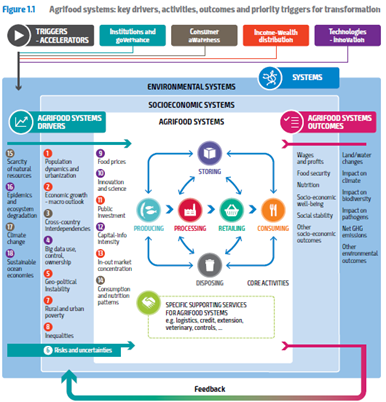
- The report, titled ‘The Future of Food and Agriculture: Drivers and triggers for transformation’, analyzed current and emerging drivers of agrifood systems and their possible future trends.
- The document said the world was “tremendously off track” to meet the sustainable development goals (SDG), including agrifood targets.
- The development paths followed by high-income countries are not replicable in low- and middle-income countries and they are not sustainable.
- A change of mindset is needed, as "more of the same" will lead the world to the point of no return. But changing the course of actions is far from easy, given the difficult trade-offs this entails.
- Gradual transition will have to be perceived as fair to be economically and socially viable. Agrifood sectors are key, yet no longer enough on their own, to ensure sustainable development and equitable access to food.
- The report urged decision makers to think beyond short-term needs. A lack of vision, piecemeal approaches and quick fixes will come at a high cost for everyone, it said.
- It also identified 18 interconnected socio-economic and environmental forces, called ‘drivers’. It analyzed how these interacted and shaped the various activities occurring within agrifood systems, including farming, food processing and food consumption.
- The key drivers included poverty and inequalities; geopolitical instability; scarcity; the degradation of resources and climate change.
What are the future scenarios for agrifood systems?
The report hypothesized four future scenarios for agrifood systems that would bring diverse outcomes in terms of food security, nutrition and overall sustainability:
- More of the same: It envisages continuing muddling through by reacting to events and crises. Its outcome would be degradation of agrifood systems sustainability and to poor living conditions for a large number of people, thus increasing the long-run likelihood of systemic failures
- Adjusted future: Some moves towards sustainable agrifood systems occur at a slow, uncertain pace. However its outcome could be lack of overall sustainability and hampering of systemic resilience in the long run.
- Race to the bottom: This portrays a world in disarray in the worst version of itself. It would have costly and almost irreversible consequences for a very large number of people and ecosystems.
- Trading off for sustainability, where short-term gross domestic product growth is traded off for inclusiveness, resilience and sustainability of agrifood, socioeconomic and environmental systems.
What are the suggestions of the report?
The document underscored the urgent need to change course so that a more sustainable and resilient future for agrifood systems is created. It proposed four key ‘triggers of transformation’:
- Fundamentally strong institutions and better governance.
- Informed and Critical consumers.
- Better income and wealth distribution.
- Innovative technologies and approaches.
However, such transformation will come at a cost and will require trade-off of contrasting objectives that governments, policy makers and consumers will have to address and balance, while tackling resistance to the paradigm shift.
Source: https://www.downtoearth.org.in/news/food/future-of-food-world-won-t-be-able-to-feed-itself-without-wider-systemic-change-says-fao-86342
https://www.fao.org/documents/card/en/c/cc0959en
Click the link below to attempt the daily MCQs and the Mains based questions.
Mt Semeru - Edukemy Current Affairs
- Context: Mount Semeru, located in Indonesia’s Java, erupted on December 4, 2022. It is exactly a year since the previous deadly eruption.
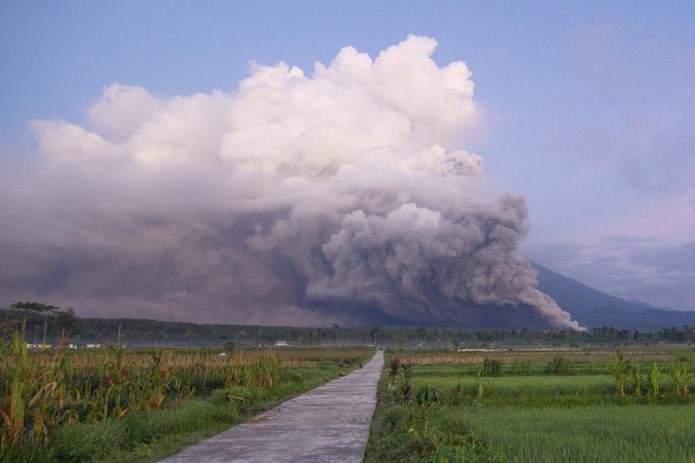
- Mount Semeru - also known as "The Great Mountain" - is the highest volcano in Java at 3,676m (12,060ft) and one of the most active.
- Indonesia sits on the Pacific "Ring of Fire" where tectonic plates collide, causing frequent volcanic activity as well as earthquakes. Indonesia is one of the most disaster-prone nations on earth.
- Located in East Java, Mt.Sumeru contains the active Jonggring-Seloko vent at the Mahameru summit, and it began erupting a few days ago.
- Eruptions have been characterized by Vulcanian and Strombolian explosions, lava flows, pyroclastic flows, lava domes, and lahars.
Sources:
https://m.economictimes.com/news/international/us/mount-semeru-in-indonesia-explodes-once-more-thousands-evacuated/amp_articleshow/96011573.cms
https://www.thehindu.com/news/international/indonesias-mount-semeru-volcano-erupts-top-alert-status-triggered/article66222473.ece
Click the link below to attempt the daily MCQs and the Mains based questions.
Dr Rajendra Prasad - Edukemy Current Affairs
- Context: India's first President, Dr Rajendra Prasad was born on December 3 in the year 1884. He was an independence activist, lawyer, and scholar and was a part of the Indian National Congress.
- Prasad entered the political arena as a volunteer in the 1906 Calcutta session of the Indian National Congress. He was subsequently elected to the AICC.
- Gandhiji undertook the ‘Champaran Satyagraha’ to support the cause of the peasants’ revolting against the forceful cultivation of Indigo by the British authorities and Dr. Prasad supported the cause.
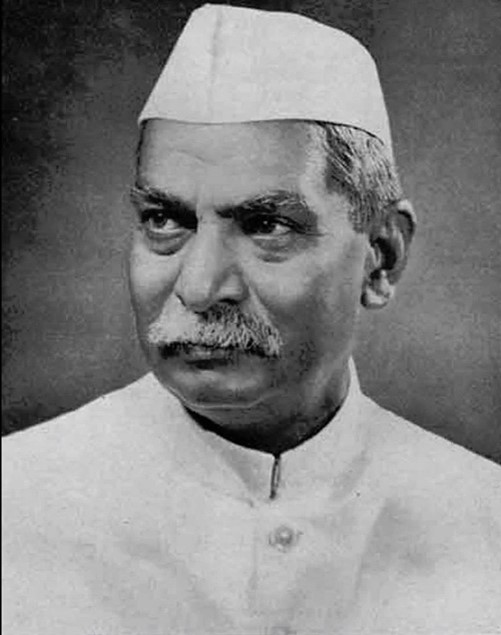
- With Gandhiji announcing the Non-cooperation movement, Dr Prasad led the programs of non-cooperation in Bihar, also collecting funds to enable the continuation of the movement.
- He upheld the ideas of Swadeshi, asking people to boycott foreign goods, peruse the spinning wheel and wear only khadi garments.
- Dr Rajendra Prasad served as the Food and Agriculture Minister in the interim Government.
- In 1950, the Republic of India came into existence and Dr Rajendra Prasad was elected to be the first-ever President of the country.
- Having been elected twice, as President of India, he duly acted as per the Constitution, independent of any political party,
- He was awarded the "Bharat Ratna", the nation's highest civilian award, in 1962.
Sources:
- https://timesofindia.indiatimes.com/india/rajendra-prasad-10-facts-about-indias-first-president/articleshow/95959231.cms?from=mdr
Image Source :
https://www.culturalindia.net/leaders/rajendra-prasad.html
Click the link below to attempt the daily MCQs and the Mains based questions.
Jagdish Chandra Bose - Edukemy Current Affairs
- Context: On the occasion of 164th birth anniversary of Acharya Jagadish Chandra Bose an “International conference on the contributions of J C Bose: A Satyagrahi Scientist” was organised Ministry of Culture.
- He was born on November 30, 1858, Mymensingh, Bengal (present day Bangladesh) and died in Bihar.
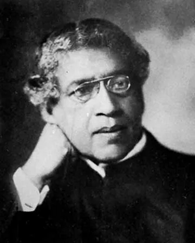
- Achievements
-
- J C Bose discovered wireless communication and was named the Father of Radio Science by the Institute of Electrical and Electronics Engineering.
- He was Indian plant physiologist and physicist whose invention of highly sensitive instruments for the detection of minute responses by living organisms and developed Crescograph which showed that plants have feelings.
- He laid foundation of the Bose Research Institute in 1917.
- He fought against discrimination in terms of salary and treatment given to Indians under British rule and organised a unique satyagraha by refusing to encash cheques despite working fully.
- His books include Response in the Living and Non-Living (1902) and The Nervous Mechanism of Plants (1926).
Source:
https://pib.gov.in/PressReleaseIframePage.aspx?PRID=1880655
Image source:
https://www.britannica.com/biography/Jagadish-Chandra-Bose
Click the link below to attempt the daily MCQs and the Mains based questions.
Kaziranga Project - Edukemy Current Affairs
- Context: Indo-French partnership in Kaziranga has resulted in reduced instances of poaching.
- The Kaziranga project is a part of a larger Assam Project on Forest and Biodiversity Conservation (APFBC).
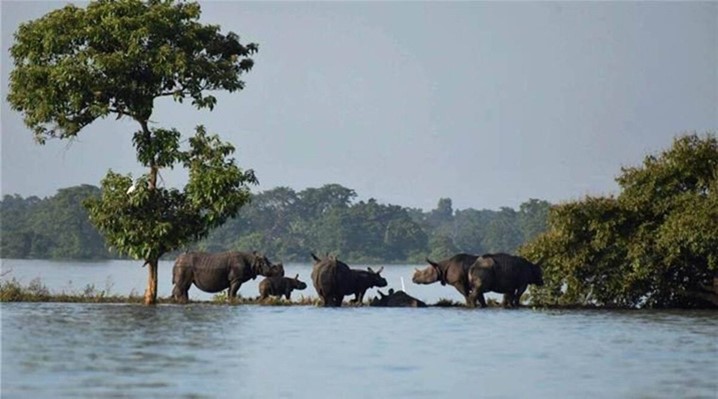
- The French organisation, Agence Française de Développement (AFD) has committed funding of €80.2 million for a 10-year period (2014-2024.)
- With French and Indian technical and financial support, the Indo-Pacific Parks Partnership will facilitate partnership activities for interested natural parks of the Indo-Pacific region. These activities include biodiversity conservation, wildlife management and engagement with local communities.
Objectives and achievements
- Artificial highlands/ embankments for animals to escape during floods.
- Anti-poaching camps
- Alternate livelihood training for local communities
- The project has also developed infrared-based early warning systems, triggered by elephant footfall, to either scare off herds from human habitat or to warn villagers.
Illegal timber trade is causing forest degradation around the reserve is a matter a concern.
|
Kaziranga National Park was declared UNESCO World Heritage Site Location: Assam River: Brahmaputra Species: One-horned Rhino and elephants |
Source:
https://indianexpress.com/article/india/in-kaziranga-national-park-indo-french-partnership-bears-fruit-8305997/
Click the link below to attempt the daily MCQs and the Mains based questions.
Graded Response Action Plan (GRAP)
Why in news? With Delhi’s air quality turning ‘severe’ again, the Commission for Air Quality Management (CAQM) has invoked stage three of GRAP.
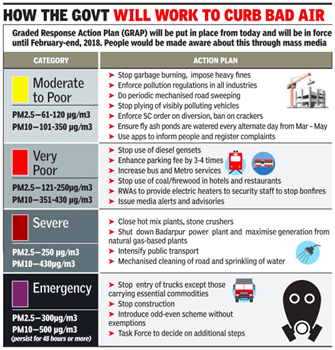 About:
About:
- The Plan was notified by the Ministry of Environment, Forests & Climate Change in 2017.
- It prevents PM10 and PM2.5 levels from going beyond the ‘moderate’ national AQI category.
- Implemented by: Commission for Air Quality Management (CAQM).
- CAQM is a statutory mechanism to coordinate and oversee diverse efforts to improve air quality in Delhi, Punjab, Haryana, Rajasthan and UP, with the underlying remedial approach.
https://indianexpress.com/article/cities/delhi/air-quality-severe-delhi-construction-demolition-ban-8305641/
Click the link below to attempt the daily MCQs and the Mains based questions.
Korku Tribes - Edukemy Current Affairs
About

- The Korku mostly resides in Madhya Pradesh, Chhattisgarh, and the adjoining Melghat region of Maharashtra.
- The Korku are primarily cultivators. They are also excellent agriculturalists and have pioneered the cultivation of potatoes and coffee.
- They live in small groups of huts made of grass and wood.
- Korku is one of the 196 languages termed endangered by UNESCO.
- A few groups have been more successful in preserving their language, especially the Potharia Korku (from the Vindhya mountains).
https://timesofindia.indiatimes.com/entertainment/events/bhopal/korku-tribal-artists-bring-gadli-dance-to-the-city/articleshow/81287583.cms
Click the link below to attempt the daily MCQs and the Mains based questions.
New Pamban Railway bridge - Edukemy Current Affairs
About:
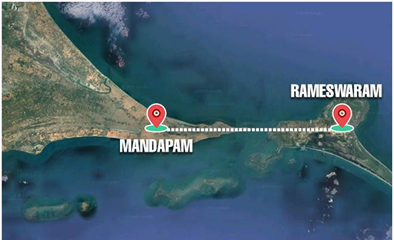
- The new 2.07 km Pamban rail bridge – India’s first vertical lift bridge – will connect the Indian mainland and the holy Rameshwaram island.
- Surrounded by the pristine waters of the Bay of Bengal, it will be a ‘showcase’ project for the entire Indian Railways.
- This state-of-the-art bridge will be the country’s first vertical lift railway sea bridge.
- The sea bridge is being executed by Rail Vikas Nigam Limited (RVNL).
https://www.livemint.com/news/india/84-of-work-on-india-s-first-vertical-lift-railway-sea-bridge-completed/amp-11670071003280.html
Click the link below to attempt the daily MCQs and the Mains based questions.
Akash Weapon System - Edukemy Current Affairs
Why in news? DRDO hands over AHSP of Akash weapon to Missile Systems Quality Assurance Agency.
 About:
About:
- Akash is a short to medium range Short Range Surface to Air Missile system which was produced by Bharat Dynamics Limited (BDL).
- Missile Akash was developed by Defence Research and Development Organisation (DRDO) to protect the areas which are vulnerable to aerial attacks.
- Missiles under Akash System are Akash Mark -I, Akash – 1-S, Akash Prime, Akash – NG.
https://www.indiatoday.in/amp/india/story/drdo-hands-over-authority-holding-sealed-particulars-of-akash-weapon-system-to-missile-systems-quality-assurance-agency-2305215-2022-12-04
Click the link below to attempt the daily MCQs and the Mains based questions.
Paris Club - Edukemy Current Affairs
Why in news? Paris Club for a 10-year moratorium on Colombo debt, global north and south to take a haircut
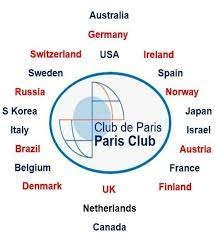 About
About
- It is an informal group, its role is to find coordinated and sustainable solutions to the payment difficulties experienced by debtor countries.
- Paris Club creditors provide debt treatments to debtor countries in the form of rescheduling.
- The Paris Club was created gradually in 1956 when the first negotiation between Argentina and its public creditors took place in Paris.
- There are currently 22 Permanent Members of the Paris Club– Unlike China and India, Japan is a member of the Paris Club.
https://www.hindustantimes.com/world-news/paris-club-for-10-year-moratorium-on-colombo-debt-global-north-and-south-to-take-haircut-101670053382948-amp.html
Click the link below to attempt the daily MCQs and the Mains based questions.
Winning Over Mothers with Hepatitis B (WOMB)
Why in news? New plan to reduce Hep-B mother-to-child infection
About:

- Launched by the Institute of Liver and Biliary Sciences and the Delhi government.
- The objective is to spread awareness about mother-to-child transmission of Hepatitis B by appointing 100 mothers with Hepatitis B as ambassadors and educators.
- The program marks 2the 5th year of the 'yellow ribbon' campaign launched in 1998 to increase public awareness about viral hepatitis.
Hepatitis B
- It is caused by the hepatitis B virus.
- It can put people at high risk of death from cirrhosis and liver cancer.
- The route of transmission is mother-to-child during birth and through horizontal transmission.
- The vaccine is available.
https://www.hindustantimes.com/india-news/new-plan-to-reduce-hep-b-mother-to-child-infection-101670103846613-amp.html
Click the link below to attempt the daily MCQs and the Mains based questions.
Space for Start-ups in Space technology: Business Standard
Exam View: India's Space Economy, Commercialization of outer space, Project NETRA, Gaganyaan Mission. For Importance of Space Sector, Challenges Related to Outer Space, Enhancing Space Self-Defense Capacities.
In News: The successful launch of Vikram-S, India’s first privately built rocket from start-up Skyroot, has focused welcome attention on the opening up of space to private enterprise.
India's Space Economy is likely to be worth nearly USD 13 billion by 2025, with the satellite launch services segment set to witness the fastest growth due to increasing private participation.
With rapidly rising public and private sector investment and an increased pace of technical innovation, the space realm is expanding like never before, ushering in The New Space Age.
While it presents numerous potentials, it also presents certain difficulties that must be investigated in order to build comprehensive views of new space and advance toward peaceful and sustainable development in the space industry.
Importance of Development in the Space Sector:
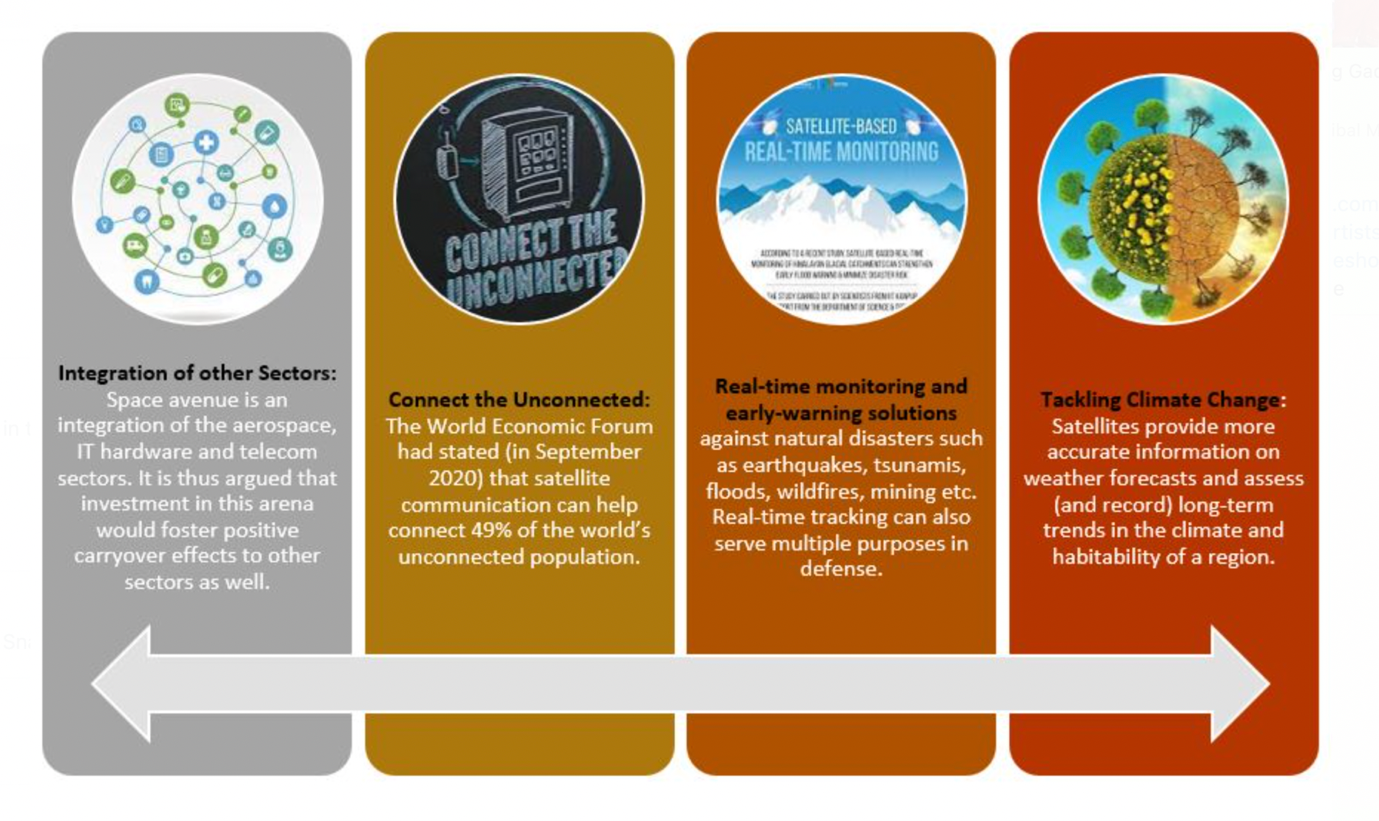
Challenges Related to Outer Space:
- China’s influence in Space: Due to the successful launch of its own navigation system, BeiDou, China has established a strong presence in space. Emerging space powers like India face a serious challenge in this regard.
- Space Debris: Increasing space exploration is causing more space debris to accumulate in the outer solar system, which can damage ongoing and future space missions due to high orbital speeds. Space Debris can also lead to ozone depletion.
- Less opportunity for Private Entry: Approximately Rs. 15,000 crore is earmarked for ISRO's annual budget, most of which is spent on building rockets and satellites. Also, the private sector has a relatively small window of opportunity.
- Global Trust Deficit: An arms race for weaponization of outer space is creating an environment of suspicion, competition, and aggressiveness across the globe, potentially leading to conflict.
- Unregulated Commercialisation: Commercialization of outer space is accelerating due to the development of satellite expeditions to provide Internet services (Starlink-SpaceX) and for space tourism (Jeff Bezos).
Way forward:
- Improvement of Space Self-Defense Capabilities: India needs to improve its space capabilities as space turns into a fourth battlefield. A good step in this approach is the development of the Kilo Ampere Linear Injector (KALI), which might be used to counter incoming missiles meant to disturb the tranquilly in the nation.
- Permanent Seat in Space: India should take the initiative to cooperate with international bodies and plan for a planetary defence program and joint space missions in the long term.
- Defending India's Space Assets: In order to effectively defend its space assets, including debris and spacecraft, India needs reliable and accurate tracking capabilities. Project NETRA, an early warning system in space to detect debris and other hazards to Indian satellites is a good step in this direction.
- Space for Women in India: India can replicate The United Nations Office for Outer Space Affairs (UNOOSA)’ Space 4Women project to promote gender equality and women's empowerment in space.
- Space awareness programmes should be established in rural areas in India, and college-ISRO internships can be developed especially for female students to introduce them to the possibility of extending their wagons beyond our planet.
- Legislative Backing to Private Entities: As per the Economic Survey 2020–2021, over 40 funded start-ups are working in India in the space segment and the number is likely to increase in the coming years.
- The current and emerging scenario justifies the need for casting the rights and obligations of private entities in legal certainty through National Legislation on private space activities in India. It would also support India in effectively discharging its obligations under UN Treaties on Outer Space activities.
Click the link below to attempt the daily MCQs and the Mains based questions.
Dharavi Slum Redevelopment - Edukemy Current Affairs
Background
Adani Realty has won the bid for the Dharavi Development project which aims to construct over 10 million square feet, at a cost of over Rs 20,000 crores. Of this, around 30% area is meant for sale while the rest is for rehabilitation of the slum dwellers.
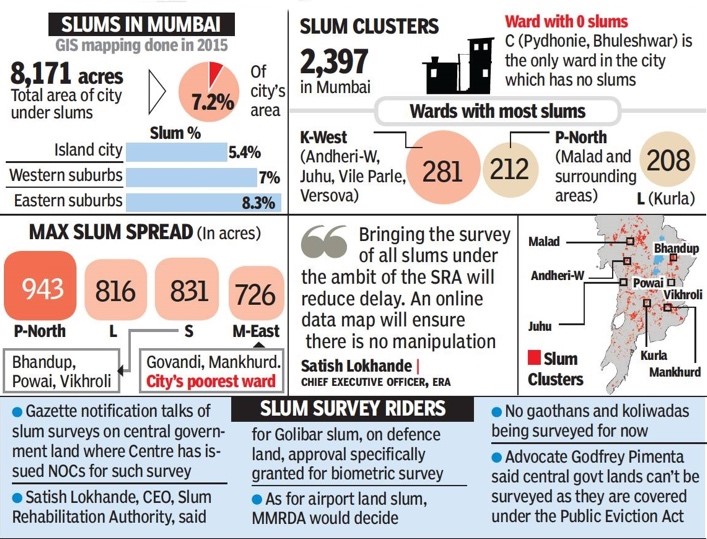
About Dharavi Slums:
- Dharavi is considered the densest slum in the Asia-Pacific region. It is also a hub for several small-scale, unorganized industries that manufacture medicines, leather, footwear, and clothes
- It came into existence in 1884 and was originally inhabited by fisher folk when the area was still creeks and swamps. Later it became attractive to migrant workers from South Mumbai.
- As per the Slum Rehabilitation Authority scheme, 35% of Mumbai’s population live in slums and 24% of Mumbai’s total area is occupied by slums.
- Slums play a transitory role in urban development. They are the basis of the economic sustenance of villages and contribute a large share of informal labour. Slums are the most convenient escapes for people escaping rural poverty, discrimination and atrocities.
About Dharavi Development Project:
- The Maharashtra government aims to complete the rehabilitation of slum dwellers where each eligible slum-dwelling family would be given a 405-square-foot flat within seven years from the start of construction.
- The entire project, including the sale component, would be completed, in 17 years. The sale component is the portion the developer will sell in the market to recover his costs.
- Local residents and small businesses are concerned about being moved out of Dharavi. They demand the engagement of locals and proper information dissemination to allay the fears of residents.
Source:
https://www.moneycontrol.com/news/business/real-estate/adani-wins-dharavi-redevelopment-project-what-next-9646501.html
Click the link below to attempt the daily MCQs and the Mains based questions.
Share the article
Get Latest Updates on Offers, Event dates, and free Mentorship sessions.

Get in touch with our Expert Academic Counsellors 👋
FAQs
UPSC Daily Current Affairs focuses on learning current events on a daily basis. An aspirant needs to study regular and updated information about current events, news, and relevant topics that are important for UPSC aspirants. It covers national and international affairs, government policies, socio-economic issues, science and technology advancements, and more.
UPSC Daily Current Affairs provides aspirants with a concise and comprehensive overview of the latest happenings and developments across various fields. It helps aspirants stay updated with current affairs and provides them with valuable insights and analysis, which are essential for answering questions in the UPSC examinations. It enhances their knowledge, analytical skills, and ability to connect current affairs with the UPSC syllabus.
UPSC Daily Current Affairs covers a wide range of topics, including politics, economics, science and technology, environment, social issues, governance, international relations, and more. It offers news summaries, in-depth analyses, editorials, opinion pieces, and relevant study materials. It also provides practice questions and quizzes to help aspirants test their understanding of current affairs.
Edukemy's UPSC Daily Current Affairs can be accessed through:
- UPSC Daily Current Affairs can be accessed through Current Affairs tab at the top of the Main Page of Edukemy.
- Edukemy Mobile app: The Daily Current Affairs can also be access through Edukemy Mobile App.
- Social media: Follow Edukemy’s official social media accounts or pages that provide UPSC Daily Current Affairs updates, including Facebook, Twitter, or Telegram channels.



